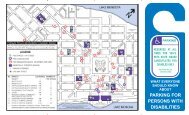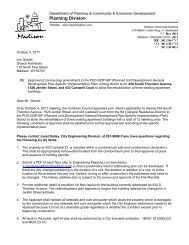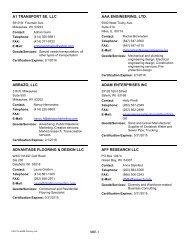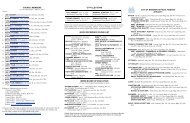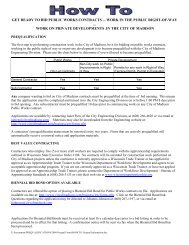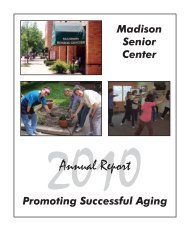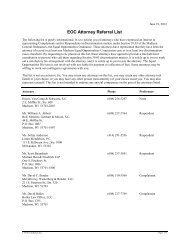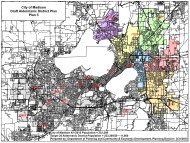Madison Cultural Plan 2011 - City of Madison, Wisconsin
Madison Cultural Plan 2011 - City of Madison, Wisconsin
Madison Cultural Plan 2011 - City of Madison, Wisconsin
Create successful ePaper yourself
Turn your PDF publications into a flip-book with our unique Google optimized e-Paper software.
<strong>Madison</strong> should<br />
improve its<br />
historic<br />
preservation<br />
ordinance.<br />
<strong>Madison</strong>’s robust historic preservation ordinance relies on language crafted<br />
decades ago when the community lacked experience with how it would or should<br />
work in practice. Now, with substantial experience to hand, <strong>Madison</strong> is grappling<br />
with the opportunity to update and revise that ordinance to be more sensible,<br />
clearer, and easier to implement. The Landmarks Commission, in collaboration with<br />
the city Preservation <strong>Plan</strong>ner, is evaluating the language <strong>of</strong> the Landmarks<br />
ordinance in an effort to clarify its intent, make it easier to interpret, and make the<br />
regulation process more predictable.<br />
Revisions should focus on improving, not degrading, <strong>Madison</strong>’s ability to preserve its<br />
historic assets. Nationally, best practices for local historic preservation ordinances<br />
call for locally crafted protection, through zoning regulation, for the historic<br />
character <strong>of</strong> districts the community deems important to its culture and sense <strong>of</strong><br />
identity. See recommendations 19, 21,22, 25, 27, and 28.<br />
Linking historic preservation skills to neighbors and neighborhood plans and creating<br />
positive incentives for preserving private property <strong>of</strong> historic merit can advance<br />
historic preservation in important ways. In order to take full advantage <strong>of</strong> <strong>Madison</strong>’s<br />
historic cultural resources and to support the sense <strong>of</strong> place engendered by its<br />
traditional neighborhoods, city planners should find ways to support and partner with<br />
organizations who bring technical preservation and conservation assistance to<br />
<strong>Madison</strong>’s traditional and historic neighborhoods. The city can explore ways to<br />
incentivize the preservation <strong>of</strong> the historic character <strong>of</strong> private properties,<br />
augmenting the Landmarks ordinance that currently compels preservation without<br />
<strong>of</strong>fering any rewards or relief. See recommendations 19, 21, 22, 25, 27, and 28.<br />
III.C.5. PUBLIC ART<br />
Across the nation, in communities large and small, public art has become an<br />
important tool in shaping the public’s sense <strong>of</strong> place. Increasingly, Americans<br />
identify places by association with works <strong>of</strong> public art. <strong>Madison</strong>’s residents are no<br />
different and have called time and again for increasing the city’s investment in<br />
both permanent and temporary public works.<br />
With the maturing <strong>of</strong> <strong>Madison</strong>’s public art program, success has brought the need<br />
for change. The program’s guidelines, process, structure, and focus should be<br />
updated and clarified. Efficiencies and increased resources are needed to sustain<br />
and grow the program.<br />
<strong>Madison</strong> <strong>Cultural</strong> <strong>Plan</strong> Findings<br />
36




